Vienna was perhaps the most important musical destination on my tour. Wolfgang Amadeus Mozart moved here in 1781 and married Constanze Weber the following year; he died here in 1791. Joseph Haydn was here as a boy and a young man, and was based here – after 30 years at Eisenstadt – from 1791 until his death in 1809. Ludwig van Beethoven lived here from 1792 until his death in 1827. Franz Schubert was born in Vienna and lived all of his short 31-year life here, until his death in 1828. Johannes Brahms lived here for 35 years from 1862 until his death in 1897. Johann Strauss father and son were born and died here (1804-1849 and 1825-1899). Gustav Mahler was director of the Court Opera from 1897 to 1907, and died here in 1911. And there are many other composers and performers with Viennese connections... / more |
Beethoven
Ludwig van Beethoven moved to Vienna from Bonn in 1792 and lived in many different houses in and around the city. Perhaps his closest approach to a permanent home was his fourth-floor apartment in the 'Pasqualati House', where he lived at several times between 1804 and 1815, and which is now a small museum. In Heiligenstadt, then a village outside the city walls, he lived at six different addresses at various times, and it was there, in 1802, that he wrote the Heiligenstädter Testament [Heiligenstadt Testament], addressed to his brothers and expressing his despair at his increasing deafness...
• Click for photos and more |
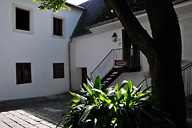 |
Haydn
Joseph Haydn was born in the village of Rohrau, 30km east of Vienna, in 1732. He was brought to sing in the choir of the Stephansdom in 1740, but when his voice broke in 1749 he was considered of no further use to the choir and was dismissed. With little formal education, but armed with the knowledge gained by his acute observation of the music of the Stephansdom he lived with some difficulty as a freelance musician, eventually becoming accompanist and servant to the Italian composer Porpora, and later moving on to work for two aristocratic patrons. Then in 1761 his life changed for ever when he was appointed by the Esterházy family as assistant Kappellmeister at Eisenstadt....
• Click for photos and more |
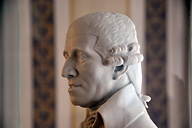 |
Mozart
Wolfgang Amadeus Mozart came to Vienna in 1781, initially at the insistence of his employer at the time, the Archbishop of Salzburg, who was visiting the city. He famously fell out with the Archbishop, gave up his job, and set out to take advantage of the musical opportunities he could see all around him in Vienna. He married Constanze Weber in 1782. Their only surviving home is the apartment on the first floor of Schulerstrasse 8, their 'best' address in Vienna and now the Mozarthaus. The museum was redesigned on three floors for the 250th anniversary in 2006, and is quite brilliant...
• Click for photos and more |
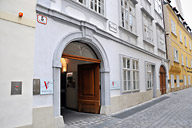 |
Schubert
Franz Schubert was the only one of the big names to be born in Vienna and to live his whole life here. In his tragically short life he wrote over 600 songs, nine symphonies, a huge number of chamber works, the sublime piano sonatas and much more. He made music with his friends and entertained others in his popular 'Schubertiades', and lived perhaps too full a life. What would he have achieved if he'd lived his full span? All that remain in the city today are the house where he was born in 1897, and the house in which he died in 1828, both of them now containing small museums...
• Click for photos and more |
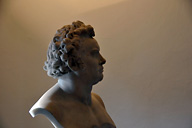 |
Musicians' Graves
From Beethoven's house in Heiligenstadt I walked to Grinzing, to find the art nouveau grave of Gustav Mahler in Grinzinger Friedhof. A day or so later, after the weather had deteriorated considerably, I took a tram to the huge and inappropriately-named Zentralfriedhof [central cemetery] and found many old friends: Beethoven, Mozart and Schubert, together as a trio; Arnold Schoenberg and the Strausses, including Josef Strauss; Johannes Brahms, Franz Suppe, and Strauss's rival Josef Lanner; and the piano makers Nannette and Andreas Streicher...
• Click for photos and more |
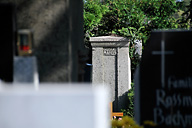 |
Musicians' Statues
Vienna's most important musicians are commemorated with statues: WA Mozart in the Burggarten, part of the Hofburg complex; Anton Bruckner, Franz Schubert and the guilded Johann Strauss II in the Stadtpark, on the south-east sector of the ring road; Beethoven not far away in Beethovenplatz, looking towards the Ring; Johannes Brahms apparently asleep in his chair in the Resselpark, looking across the traffic to the Musikverein, Vienna's top concert hall and home of the Vienna Philharmonic Orchestra...
• Click for photos and more |
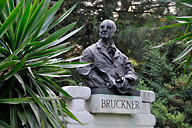 |
Karlskirche
The Karlskirche was billed as the finest Baroque church in the city, and indeed its interior is remarkable: much gold and warm textured marble, offset with white, but not overpoweringly ornate. They are working on a restoration of the building, and a lift goes way up to the base of the dome, so that visitors can get a closer look at the wonderful frescoes – a rare treat. There are then some slightly wobbly stairs into the cupola at the very top. Incredible! I spent some time taking photos of the figures close up...
• Click for photos and more |
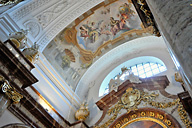 |
Michaelerkirche
The Michaelerkirche, mostly a relatively plain church but with a highly decorated Baroque chancel, was quieter than the extravagent Peterskirche nearby; peaceful, only a few people here, some recorded music (I assume of their own choir) playing gently in the backgound. The 17-year-old Haydn played the organ here in 1749, and Mozart's Requiem was first performed here soon after his death. The church dates back to 13th Century, although the neo-classical facade onto Michaelerplatz was added in 1792.
• Click for photos and more |
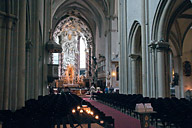 |
Peterskirche
The Peterskirche is the showpiece Baroque church in the old city, and it is indeed impressive. It's set back a little off Graben in a small square of its own, and was built by Hildebrandt in 1733. The interior is dripping with ornamentation; the heavy fresco in the dome is by Johann Michael Rottmayr, who also painted the frescoes in the Karlskirche, and there is an elaborately decorated pulpit, facing a monument by the sculptor Lorenzo Matielli, showing the Czech martyr St John of Nepomunk being thrown off the Charles Bridge in Prague in 1393...
• Click for photos and more |
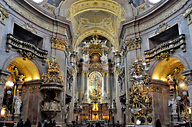 |
Stephansdom
The Stephansdom, Vienna's great cathedral, sits right at the city centre, towering over its immediate neighbours and dominating the skyline when seen from a distance from places like Schönbrunn. The pitch of its distinctive multi-coloured chevron roof is so steep that the pattern can be seen quite well from ground level. I didn't want to go on a tour of the inside, so I did what I could with the dark interior and its quite dark stonework: some shots of the early 16th century pulpit with its superb staircase...
• Click for photos and more |
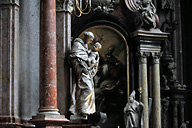 |
Schönbrunn
Schönbrunn Palace was only four stops on the U-bahn from my hotel. On this trip I wasn't so interested in the interior, but definitely wanted to take some photos in the huge gardens. So I was up early and looked out of the window to see a hint of blue in the lightening sky. I arrived at Schönbrunn at 7:00 and walked across the huge gardens the 1km or so to the Gloriette, from which there is a good view of the rear elevation of the palace. The light was fabulous, cutting across the tops of the impeccable flower beds...
• Click for photos and more |
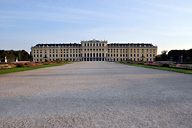 |
In the City
One of the very nice things about Viennese life is the traditional café, where time passes more slowly, service is still important and the old decoration is impeccable. I photographed the outside of Café Sperl when the sun was still shining, just after I'd arrived in Vienna. Café Sperl was used by Brahms, and by the Hungarian operetta composers Kálmán and Franz Lehár. Shortly before I left the city I called in for a coffee, and a slice of what is surely the best chocolate cake in the world...
• Click for photos and more |
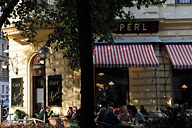 |
On departure day I was up at 07:00 for final packing, after five days and six nights in the city. Into breakfast at 08:00. Paid the bill and out at 08:40 with the heavy case. Trundled down to Pilgramgasse and staggered onto the 13A bus to the Südbahnhof. A cold wait in the departure hall as the incoming train was late arriving (from Prague I think). When it did arrive there was a big scramble for seats and I was glad to have a reservation, in a compartment for six with four others; I heaved the case up onto the rack...
Thoughts on Vienna as I move on to Brno and Prague: A busy city, hard work for me but very enjoyable; much interesting stuff, though it didn't grab my heart like Salzburg. I didn't have a chance to visit Vienna's remarkable art galleries; they're for another time. A couple of rude and offhand people, but many nice ones as well. A lot of travelling, as I knew there would be, but the Viennese public transport system is superb, and I enjoy planning and using it. The weather didn't help either my mood or the photography: in September it should be 20-22 degrees, falling slightly during the month, but in fact it was 29 degrees as I arrived, towing my case and sweating, but as I leave it's 10 degrees C and dull.
UPDATE, June 2009: I did get back to see the wonderful art galleries – the Albertina, Belvedere, Kunsthistorisches Museum, Leopold Museum, the Secession building, and MAK (the Museum of Applied Art). There are some photos from that visit in my Vienna Squared gallery. And in fact my comment above is wrong: Vienna did grab my heart, and I have to go back yet again. It's a big city to settle into, and on the Grand Tour I was working hard with the weather often against me. |
|
|